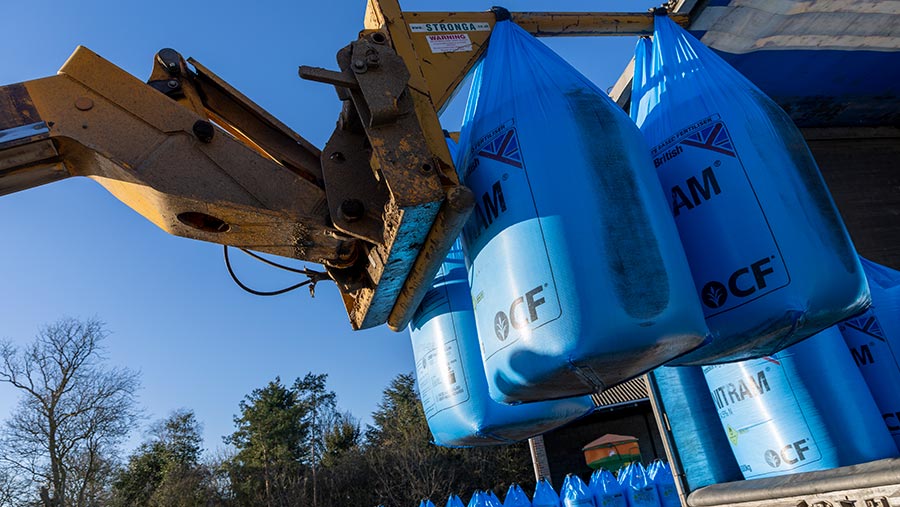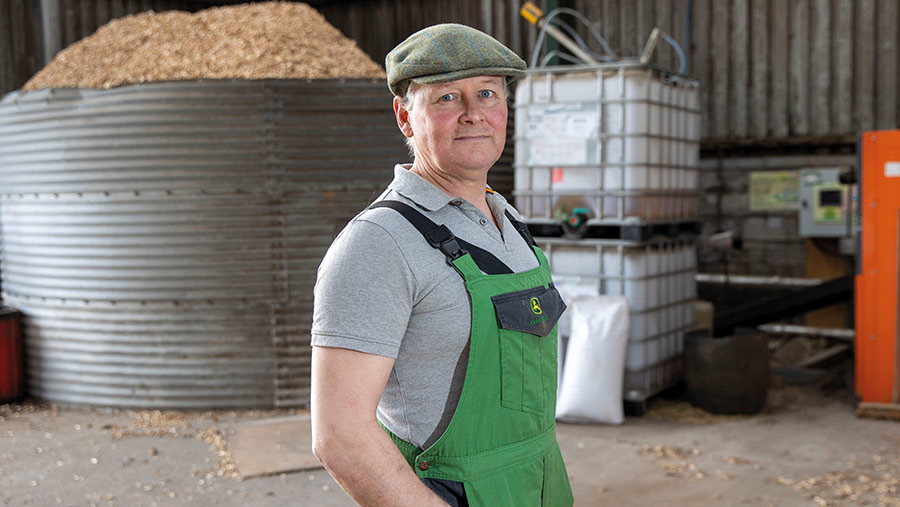How ag Inflation is affecting farm inputs
 Unloading AN fertiliser © Gary Naylor
Unloading AN fertiliser © Gary Naylor The latest figures from the AgInflation Index – fertiliser costs have jumped by 133.8% – demonstrates the growing financial pressure that farm businesses are under.
We look at the current state of play, where there are options for saving costs, and what one of our Transition Farmers is doing to beat rising prices.
See also: On-farm renewable energy generation: What to consider
Input prices
Farming input costs jumped by 34.15% in the year to 30 September, according to the AgInflation Index published by the farmer-owned AF Group.
The annual increase exceeds an increase of almost 22% recorded last year.
Seven of the nine farm input categories measured by the index have seen double-digit inflation. The greatest increases were in the price of fertiliser (133.8%), fuel (42.8%) and animal feed and medicine (36%).
No farming enterprise has avoided double-digit inflation.
The highest cost increases were seen by cereal and oilseed rape growers (40.1%), potato producers (39.7%) and dairy farmers (36.9%).
Beef and lamb producers saw a 34.8% cost increase.
AF Group chief executive David Horton-Fawkes urges farmers to work with suppliers in a bid to secure the best input prices.
Good communication at an early stage and accurate forecasts of likely input requirements was important, he adds.
“The more notice we have, the more time we have to procure inputs for members at the best possible price. This is the end of just-in-time farming – we really have to plan ahead and look at the ‘what ifs’.
“We are urging our members to plan their cashflows and use our index to work with processors and advisers to confront these brutal facts, because business as usual in 2023 is not going to be an option.”
Energy was a particular challenge, says Mr Horton-Fawkes.
“Electricity prices have virtually quintupled. Although we have the benefit of the government’s energy price cap, which is very welcome, prices are still probably double what many farmers have been paying.”
Latest indications suggest the price cap will be lifted in April 2023. Although ongoing political and economic instability – including pressure on public spending and the value of sterling – means that could change.
“The energy price cap will provide only temporary respite because the cap is limited and is not an open-ended commitment.
“Farmers are tough and resourceful and we’ve all had our fill of doom and gloom, but no one can afford to ignore these results.”
AgInflation Index
The AF AgInflation Index is a weighted average of the real costs of more than 130 items using data from AF buyers who purchase more than £250m of farm inputs annually on behalf of 3000 farmers.
Each year, AF purchases:
- 200,000t of fertiliser
- 14,00t of cereal and pulse seeds
- 105,00t of feed
- 90m litres of fuel
- £2m of tyres
- £10m+ of building materials
Source: AF Group
Is there room for cost saving?
The end of the price cap would have a huge impact on farm businesses and agricultural suppliers, says Mr Horton-Fawkes.
“We’ve no idea where it could go. But if it goes back to where it was, it’s going to represent a very serious challenge.”
Farmers should consider any likely adjustments – including using less fuel – if the price cap ends, he adds. “On our own farm at home, we have gone through every single cost line and asked ourselves: ‘What can we do to reduce it?’
“I had a call from a farmer the other day whose accountant had asked whether he had sold off some of the machinery because the farm fuel bill had reduced by 30%.
The answer was: ‘No, we haven’t. We’ve just been extremely disciplined about the way in which we’ve used our machinery’.
Not everybody has that flexibility – but there are incremental gains to be had by looking at everything in detail.”
Some farm input costs have risen much less than others. They include farm labour (6%), contract and hire (8.7%), crop protection products (13.3%) and machinery and plant hire (25.4%).
As a not-for-profit co-operative, the AF Group is working as closely as it can with farmers and suppliers, says Mr Horton-Fawkes.
Some distributors are offering deferred payments but it is not always possible to extend credit deadlines.
Market volatility
Market volatility is affecting farm input availability and pricing across a number of sectors – including fertiliser, animal feed, seed and crop protection.
This is especially the case where inputs are imported.
“The real challenge we have is energy and that probably won’t come as a surprise,” says Ed Barker, head of policy at the Agricultural Industries Confederation, which represents 230 farm suppliers and £8bn of farmgate turnover.
Uncertainty over longer term prices means suppliers are still trying to get to grips with where their energy costs are likely to sit next year.
“While we really welcome the thrust of the scheme to effectively place a cap on costs, suppliers and energy brokers simply don’t have the information they need to be able to provide accurate quotes.”
Many farm suppliers remain unable to fix their energy costs, and it is difficult to secure long-term contracts. The situation is particularly challenging for suppliers reliant on liquefied gas and heating oil.
Currency fluctuations and the fallout from the government’s mini Budget aren’t helping either, says Mr Barker.
“Animal feed and crop protection products are priced in dollars and there has been considerable movement in the value of sterling.”
Suppliers are keen to understand farmers’ intentions sooner rather than later when it comes to securing farm inputs.
“Communication is key and that works both ways up and down the supply chain,” says Mr Barker.
This should include avoiding the temptation to order inputs at the last minute. Although gas prices are coming down, domestic and imported fertiliser supplies and prices remain uncertain.
Transition farmer Andrew McFadzean

Andrew McFadzean © Jeff Holmes
Transition farmer Andrew McFadzean has reduced his reliance on bought-in energy to help secure a sustainable future for his business.
Two biomass boilers supply energy to 195ha Dalchomie Farm, near Maybole, Ayreshire. They also generate an important income from Renewable Heat Incentive payments.
A 200kW biomass boiler supplies hot water to a high-pressure washer and heats the office and houses. A 350kW unit heats a wooden grain-drying floor, helping to offset the cost of 20-30 annual drying days.
The units are fed by 600t of wood annually, bought in 12ft lengths, then dried and chipped on-farm. Some woodchip is sold to local farmers, creating another revenue stream alongside the beef and arable enterprises.
Mr McFadzean says the venture has helped to cushion the farm from rapidly increasing energy prices.
Its success has prompted a plan for solar energy under a 25-year investment scheme.
Two 200kW units totalling 500 solar panels will be installed on the roofs of two new buildings. Batteries storing 30kW will send power to the grid at the highest price point.
